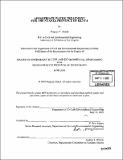Appropriate water treatment for the Nyanza Province of Kenya
Author(s)
Alekal, Pragnya Y. (Pragnya Yogesh), 1977-
DownloadFull printable version (8.978Mb)
Other Contributors
Massachusetts Institute of Technology. Dept. of Civil and Environmental Engineering.
Advisor
E. Eric Adams.
Terms of use
Metadata
Show full item recordAbstract
In 2000 the Centers for Disease Control and Prevention (CDC) in conjunction with CARE International began working with several local non-governmental organizations (NGOs) in the Nyanza Province of Kenya to reduce the rate of waterborne diseases. In 2002, CDC partnered up with the Society for Women and AIDS in Kenya (SWAK), a local NGO, to implement safe water treatment in SWAK-affiliated communities. SWAK is seeking ways to improve and expand sales of safe water treatment products in all of its communities. The water treatment sales expansion study has two components: · A technical component that addresses the most appropriate treatment · A business component that addresses marketing and sales of the products. This study focuses on the technical component. Its purpose is to evaluate the most appropriate water treatment in SWAK communities in the Nyanza Province. Three water treatment products were assessed - WaterGuard®, PuR®, and an alternative naturally occurring coagulant made of seeds from the Moringa tree. WaterGuard® is a chlorine- based disinfectant; PuR® is a coagulant and chlorine-based disinfectant. Both are already being marketed by SWAK. Moringa trees are indigenous to the region. Research was conducted in the United States and Kenya from October to April 2005. Field evaluation in Nyanza during January consisted of surveys that addressed water treatment practices, and water quality tests, specifically turbidity which interferes with the effectiveness of chlorine-based disinfection. Research revealed that rainwater is the best water source, and WaterGuard® is the best water treatment. PuR® was hardly used, and Moringa needs to be studied further for cost-efficiency and availability. (cont.) A set of recommendations were drawn up and presented to SWAK communities, based on the results. These include promotion of rainwater treatment, retreatment of water every 24-48 hours, and health education programs.
Description
Thesis (M. Eng.)--Massachusetts Institute of Technology, Dept. of Civil and Environmental Engineering, 2005. Includes bibliographical references (leaves 41-44).
Date issued
2005Department
Massachusetts Institute of Technology. Department of Civil and Environmental EngineeringPublisher
Massachusetts Institute of Technology
Keywords
Civil and Environmental Engineering.